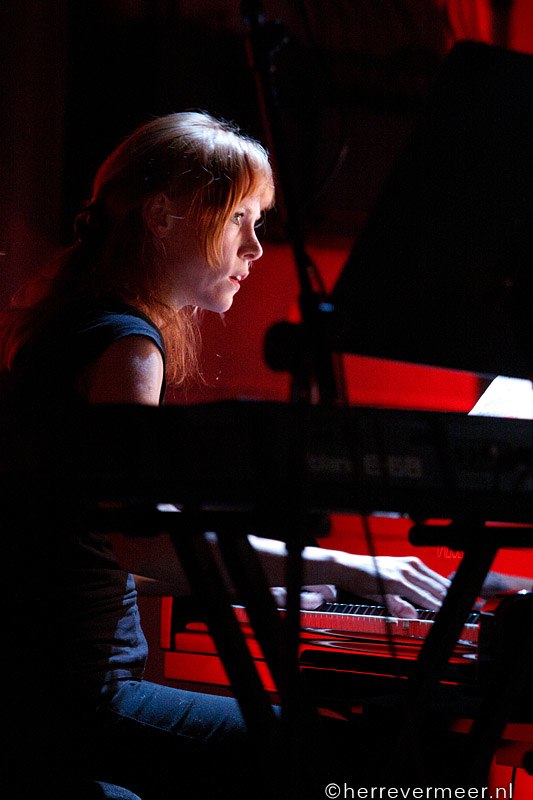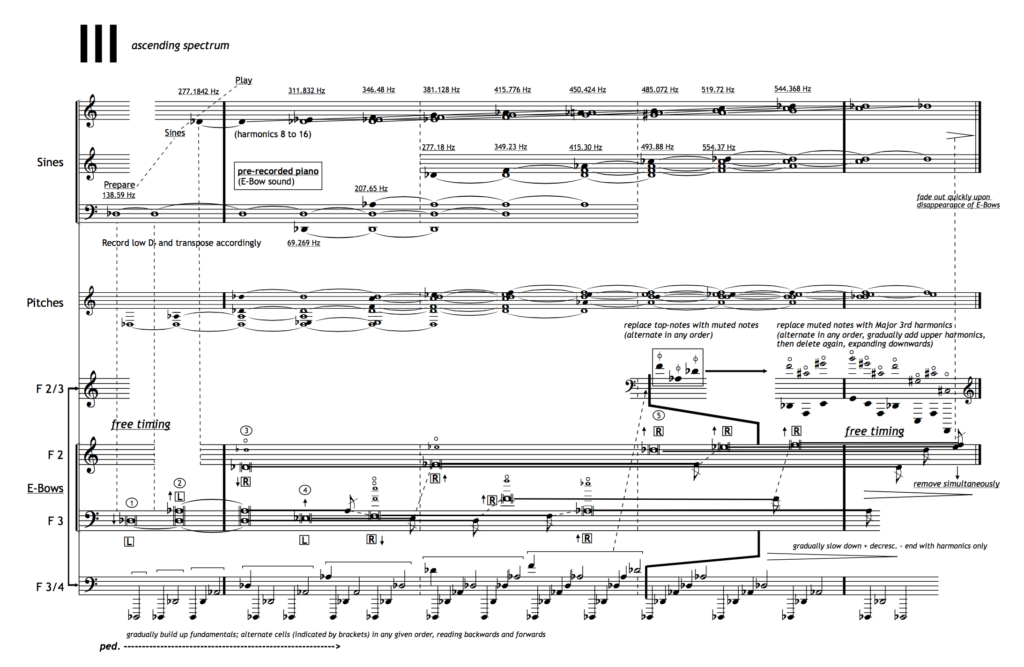Bob Gilmore on Peter Adriaansz’s Waves
Bob Gilmore’s insightful liner notes from Ensemble Klang’s recording of Peter Adriaansz’s Waves (EKR01).
The four compositions on this disc, modest in instrumentation and gentle and undemonstrative in manner, offer a musical exploration of enormous themes: motion and stillness, time and timelessness, existence and non-existence. If music can be a medium in which to explore the most profound existential questions, as the mediaeval scholars believed it could, then each generation must rephrase these questions to make them relevant to their own time. Few contemporary composers have delved so fearlessly into this realm as has Peter Adriaansz. His recent work is abstract music of a high order, reanimating the mediaeval idea of music as applied number: but the questions it asks are defiantly of the twenty-first century, questions about musical perception, about the nature of sound and the passage of time.
“There is in this music something of the self-negation of religious art, and to a similar end: the wish to cleanse the ego of its excesses.”
On the surface, this is music that moves very slowly; it is mostly composed of long tones that either do not change at all, or change only in our perception because of incidents in the sonic ecology that surrounds them. Harmonic movement happens very gradually; rhythmic activity is understated or at times suspended entirely. Yet the calm surfaces of these works (for example the gorgeous, serene beginning of Wave 5) are not always what they seem; underlying musical tensions sometimes become audible, subtly changing the atmosphere. Adriaansz’s superb control of harmonic colour helps shape the elegant and unpredictable way these pieces unfold, the way they play off motion and stillness, striving and resignation, against each other.
There is in this music something of the self-negation of religious art, and to a similar end: the wish to cleanse the ego of its excesses. Listening to these works invites a quality of attention that calms the mind. This sort of listening is made possible by an extreme reduction of material which, far from being an impoverishment, creates a state of wonder. Listening to the single interval C-Db at the beginning of Wave 11 gradually being “filled in” microtonally, the idea that somehow we might need other pitches to make life interesting seems absurd, greedy, strangely irresponsible. In these and other ways Adriaansz brings about a change that is partly a change of musical language and partly a change of mind – the mind of the listener.
 Performing in Utrecht at the festival dedicated to the music of Peter Adriaansz 'Breaking the Waves'
Performing in Utrecht at the festival dedicated to the music of Peter Adriaansz 'Breaking the Waves'
Adriaansz’s earlier compositions – those written in the decade or so before the pivotal year of 2005 – marked him out as a strong voice within the Dutch musical landscape, although always an idiosyncratic one. His compositions manifestly did not share the characteristically Dutch fondness for irony and emotional coolness. They could be provocative and outrageous (as in the wildly dissonant Comfort (2001) for orchestra or Battle Hymns (2001) for voice, piano and percussion), or highly personal and intimate (but at the same time naughty, as in the song cycle Om Jou (1999)). Yet a deeply affecting vulnerability is apparent in these early works, a need to communicate something important but perhaps unpopular, a refusal to “play the game” of the career composer. In retrospect, the enormous change in the language and technique of Adriaansz’s music that occurred at the beginning of 2005 may not be as unexpected as it seemed at the time. Foreshadowed by the Triple Concerto (2003) and the last section of Serenades II-IV (2004) for four electric guitars, he began – in a series of works entitled Structures – to write music that got rid of all superficial busyness, that abandoned any wish to be entertaining, that opened up certain areas of freedom for the performer, and that began to work with time and harmony in very sophisticated ways. The music became meditative, rather otherworldly.
Several strands of interest, insofar as these can be disentangled, led Adriaansz to this new phase in his musical development. One was his work as Artistic Director of Percussion Group The Hague, in the course of which his exploration of percussion instruments from all parts of the world (including newly invented ones) demonstrated the complexity of the interconnections between sound, tuning and culture. Another was his strong sympathy to various forms of American experimental music then barely accepted in Holland, among them the conceptually elegant compositions of James Tenney. Yet another was his increasing immersion in Far Eastern musical and philosophical systems, and his fascination with conceptions of “sound” and “time” radically different from the western ones he had inherited. (All his scores since Waves 5-7 are prefaced by a quotation from Chapter 7 of Hazrat Inayat Khan’s The Mysticism of Sound of 1923: “The mystery of sound is mysticism; the harmony of life is religion. The knowledge of vibrations is metaphysics, and the analysis of atoms science; and their harmonious grouping is art”.)
Adriaansz’s recent compositional trajectory resembles a research project, each new work building systematically on its predecessors (although with occasional “gaps” and surprising mutations characteristic of any truly evolutionary process). What seemed in 2005 like a drastic reduction of language has expanded and enriched itself in subsequent years to embrace an ever-widening range of techniques and materials. The constant elements have been a devotion to sound rather than to notes on the page; a love of clear and comprehensible musical structures; and a fascination with “audible mathematics”. His recent music has the elegance and beauty of a mathematical theorem, apparently objective and unassailable yet made into real music – sonically as well as conceptually – by Adriaansz’s fastidious ear.
 Saskia Lankhoorn performing work by Peter Adriaansz
Saskia Lankhoorn performing work by Peter Adriaansz
Waves 3
Wave 3, for amplified piano, sine tones and sampled string sounds, is the third in a cycle of four works for solo pianist composed early in 2007. Unlike the subsequent works in the Waves series, these four pieces are essentially independent compositions that may, as here, be programmed separately. Although designed for a single performer (with an assistant who manipulates the sine tone patch), the sound world and the performance practice of Wave 3 is much more complex than that of a conventional solo piano work. The piece makes use of five eBows, battery-powered devices that create an electromagnetic field capable of exciting a string without it having to be plucked; this creates a rather ghostly and quasi-infinite vibration, the resulting sound being sustainable for as long as the battery lasts. In performance the pianist’s right hand operates the eBows, which must occasionally be moved and placed on different strings inside the piano, while the left hand plays both conventionally, on the keyboard, and plucks the strings directly; in addition, a given string must sometimes be muted, or Adriaansz asks for a specific harmonic to be sounded. The performance is truly an act of choreography for the pianist, who must negotiate her way around a complex, three-dimensional performing space. Meanwhile, a separately controlled sine tone patch slowly makes an ascent from Db above middle C (277 Hz) to the octave above. This precisely determined electronic sound-source interacts with the acoustic (and somewhat less predictable) vibrations of the piano strings to generate a texture rich in psychoacoustic fascination. Wave 3 was written for Sonsoles Alonso and Jorrit Tamminga.
 Waves 3 by Peter Adriaansz
Waves 3 by Peter Adriaansz
Waves 5-7
Waves 5-7, for variable, amplified ensemble, was written for Ensemble Klang in late 2007. This work retains the eBow piano as an indispensable part of the ensemble sound. Here it forms the core of one of the two “families” of instruments for which the work is conceived: generating instruments, which produce mainly pure tones (piano and electric guitar, also played with an eBow); and responding instruments (percussion and wind instruments). The purpose of the latter group is to extend or alter, through colour change, microtonal inflection or sharply differentiated articulation, the “eternal” sound world of the eBow piano and electric guitar. That “eternal” world is less conventionally perfect than it might appear, however: while the long piano tones use conventional, equal-tempered pitches, the guitarist is instructed to depart from those tones by subtle microtonal inflections. In the central movement, Wave 6, Adriaansz for the first time specifies actual microtonal intervals, eighth-, sixth- and quartertones, centering around a three-octave B natural. This opened the door to a new approach to harmony and simultaneously creates a wealth of textural intricacy through the beating of near-unison tones. This work therefore represents a personal rapprochement with microtonality, an interest that would resurface in Adriaansz’s subsequent works. (In terms of its larger structure, Waves 5-7 offers a satisfying upward movement of harmonic fundamentals, from Bb to B, C, and finally D.)
Waves 11-13
Waves 11-13, completed in March 2008 for the Loos Electronic Acoustic Media Orchestra, is a further development of the ideas of the preceding works. Cast in three sections of six minutes each, this work also retains the eBow piano as the basis of its soundworld but adds one other all-important element: an obbligato sine tone part, which functions as another “eternal” voice in the texture, combining steady tones with moving ones in very slow glissandi. Conceptually, the use of these sine tone sweeps allows Adriaansz to explore the relationship of microtonal motion and time. Against them, the other players make regular, periodic entries; for some players the pitches are specified precisely, while other players freely choose their note from a gamut of “available pitches”. These periodic entries allow the players to assume soloistic roles, standing out temporarily from the rest of the ensemble; careful listening is required to place these notes effectively in the surrounding texture. The microtonal divisions in this piece demand increments as small as a tenth of a tone. The outer two sections of the work also introduce a new feature in the form of extremely low, periodic sub-tones, far below the range of the rest of the ensemble. These “sound-chasms”, as Adriaansz describes them, open up the texture unexpectedly, recontextualising the music’s concentration on subtle shades of pitch in the treble register.
“Nu descendant un Escalier is a modest but delightful addition to the Adriaansz catalogue”
 Peter Adriaansz, photo © Gerrit Schreurs
Peter Adriaansz, photo © Gerrit Schreurs
Very different from Waves in tone, form and dimensions, Nu descendant un Escalier is an uncharacteristically short piece written for an Ensemble Klang project in 2008. The title evokes the famous 1912 painting by Marcel Duchamp, one of the emblematic images of avant-garde art. Duchamp declared that his painting represented a convergence of two of his chief interests, cinema (then still in its infancy) and photography: a kinetic act that takes only a few seconds to perform – walking down a staircase – is broken up into twenty or more static shots. Adriaansz’s piece is not in any sense an illustration of the painting but works by association. Each of its three short sections “descends”, both locally in terms of melodic contour and globally in terms of harmonic progression; and the sense of motion resembles that of the nude in Duchamp’s painting, from being “in focus” at the start, then blurred (by the sliding figures in saxes and trombone), to being almost stationary at the end. (It should be added that, like many of the most apparently inevitable titles, this one was added after the piece was composed.) Nu descendant un Escalier is a modest but delightful addition to the Adriaansz catalogue, showing an ability to work convincingly outside the terms of discourse he has recently set himself: his compositional journey is still a long way from harbour.

